Prices have been brought up to date, and are for stamps in 'average' condition. The currency is now selectable, the default is British Currency (£). I have revised Hiscocks' original listing, though leaving references to the original designations. The new designations have 'RH' numbers (Revised Hiscocks) to avoid confusion. Setup |
There is now a new website, put together by Ian Pinwill and Paul Ramsay, dedicated to the GB Post Office Telegraphs.
It includes information on the creation of the set and statistics on the current scarcity,
along with multitudes of images, including from the Royal Philatelic Collection.
Steve Hiscocks wrote in 1982:
Following the passing of the Telegraph Act in 1868 the inland assets of the private telegraph companies were purchased by the Postmaster-General in
1869 and 1870 and integrated into a national system. Until 1876 postage stamps were used on plain forms or on forms incorporating a 1s embossed
stamp. Both telegraphically used postage stamps and stamped forms are outside the scope of this catalogue. Telegraph stamps were introduced on
1 February 1876 and the use of postage stamps after 24 April was forbidden. The first issue included the 1d, 3d, 1s and 5s. The need for further
values led to a second issue on 1 March 1877 (4d, 6d, 3s, 10s, £1 and £5) and on 1 April 1880 a ½d value was introduced. All telegraph stamps were
withdrawn on 1 November 1881 and remaining stocks were destroyed. Postage stamps have been used ever since.
| Shortcuts to different sections: | ||||||||||
| watermarks | ½d & 1d | 3d | 4d & 6d | 1s | 3s | 5s | 10s, £1 & £5 | Notes & Perfins | Statistics | Panes |
| Essays | Imprimaturs & Proofs | Specimens | Colour Trials | Postal use | Stationery | Telephone stamps |
Perf. 14 except where otherwise indicated. For watermarks see above.
Look here for an explanation of the table.
This is modified, since L&H do not quote scarcities for these, only estimates for quantities issued.
The dates given for earliest known use are taken from the article by Ian Pinwill and Tony Finch in the Nov/Dec 2011 issue of The GB Journal.
Should you have an earlier example that you wish to be recorded, please send a scan and I will update the list and forward the scan to the authors.
For used stamps, these quantities are rather academic since current scarcities reflect quantities 'rescued' rather than printed.
Since mint stamps could be purchased over the counter however, these quantities more accurately reflect numbers issued.
I have not quoted SG numbers since they are concerned about protecting the copyright on their numbers,
whereas Hiscocks explicitly allows the use of his numbers for non-profit purposes.
The following watermarks were used, as viewed from the back with the stamp upright :
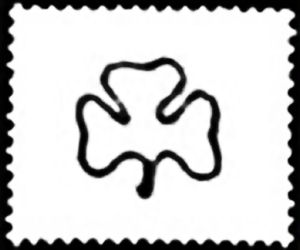 |
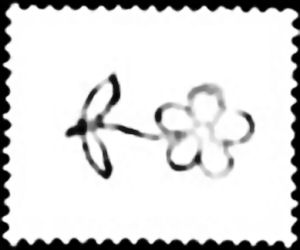 |
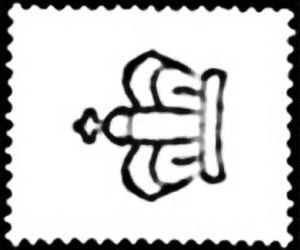 |
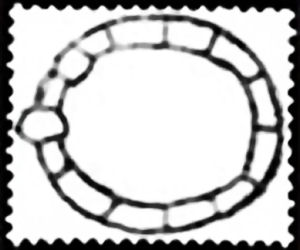 |
| Shamrock | Spray of Rose (sideways) | Crown (sideways-inverted) | Garter (sideways) |
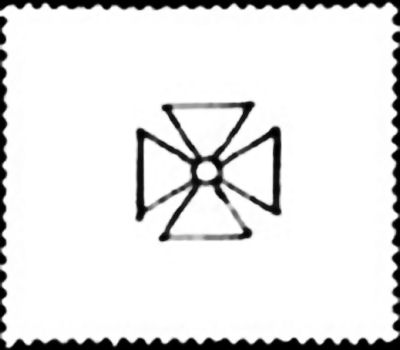 |
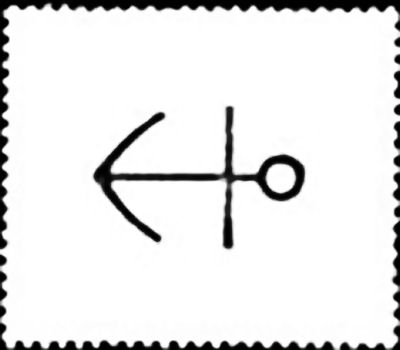 |
| Maltese Cross | Anchor (sideways) |
The Halfpenny and One penny stamps had the shamrock watermark. Plates 1 to 3 were used for 1d (1/2/76), plate 4 was never used, plate 5 was converted to the Halfpenny before use (1/4/80).
Plates 1 and 2 are known with inverted watermarks. Langmead and Huggins also list plate 3 with inverted watermark. There is an unconfirmed report of a halfpenny with inverted watermark.
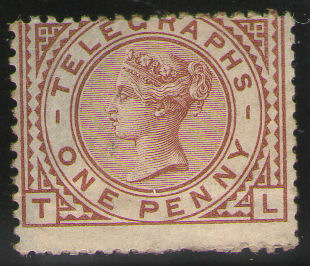 |
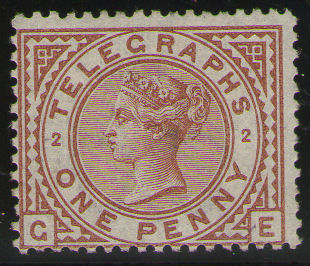 |
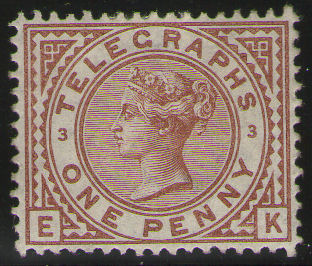 |
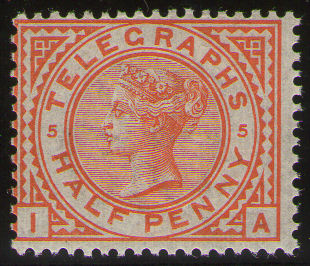 |
| 1d plate-1 | 1d plate-2 | 1d plate-3 | the ½d started out as 1d plate-5 |
Imprimatur courtesy of Grosvenor Auctions.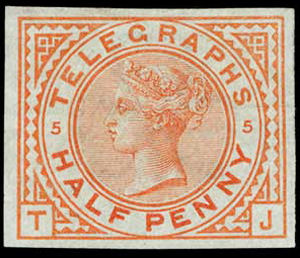 Issued stamp. 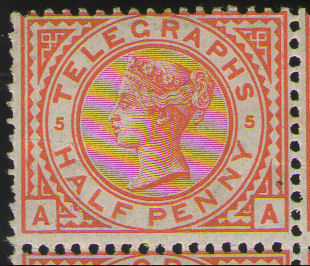 |
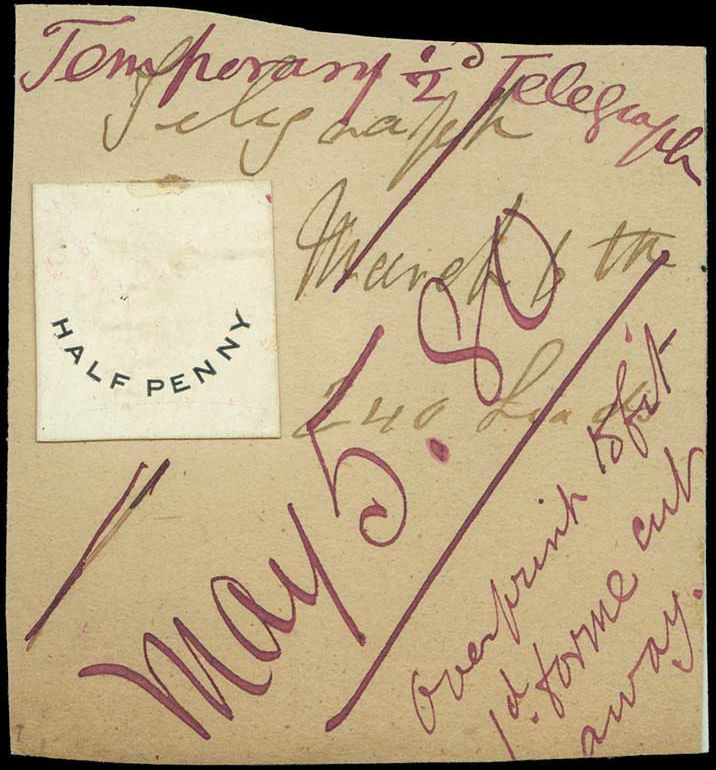 |
| The ½d was made from 1d plate-5 by removing 'ONE PENNY' and using a separate plate to print 'HALF PENNY' shown courtesy of Grosvenor Auctions. Compare the alignment with the ½d above. This is described as "Temporary ½d Telegraph May 5.80", however it was never replaced. | |
The Three pence stamps had the spray-sideways watermark initially for Plates 1 to 3 (1/2/76). This meant there were wing margins on stamps with 'D', 'E', 'H' and 'I' in the bottom right corner.
From early August 1881, the stamps were printed on Crown-sideways watermarked paper for plates 3 to 5 (sideways-inverted for plate 3).
This required a change in the plate layouts so there were no longer wing margins.
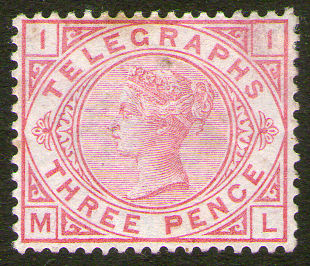 |
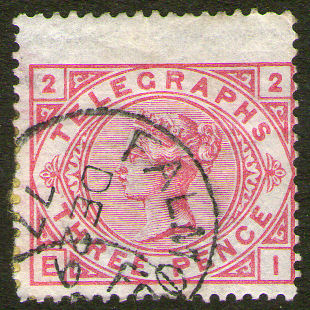 |
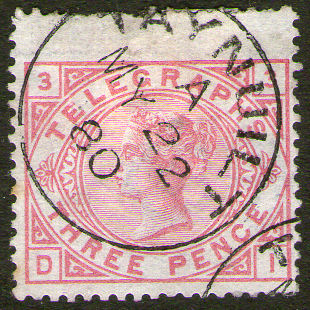 |
| 3d plate-1 | 3d plate-2 | 3d plate-3 |
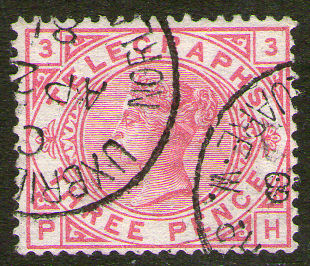 |
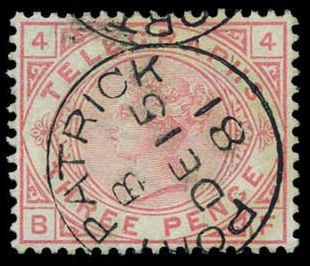 |
 |
| 3d plate-3 on Crown watermark. | 3d plate-4 - courtesy of Grosvenor Auctions | 3d plate-5 - courtesy of Grosvenor Auctions |
Note that plates 4 and 5 are very scarce.

On the 3d with spray wmk., all plates are normally sideways, but also known with sideways-inverted watermark.
SG and Stoneham both leave plate 2 unused and plate 3 used, unpriced. Langmead and Huggins do not list plate 3 sideways-inverted.
Ian Pinwill (who recorded the first example, GD, in the GB Journal) has now recorded 7 used at Bishopstoke on 23/9/80
with sideways-inverted watermark, and an additional 2 with normal (sideways) watermark.
We would both be interested to hear of more examples of Bishopstoke with similar dates.
On crown watermark, plate 3 is normally sideways-inverted, though Stoneham has this erroneously listed as sideways.
The Four pence has only plate 1 and is only on Large-Garter sideways watermarked paper (1/3/77) [NOT sideways-inverted as SG-Spec Vol.1 15th Edition. says]
These (should) have wing-margins on stamps with 'F' or 'G' in the bottom right corner.
The Six pence value started with Spray-sideways watermark for plates 1 (1/3/77) and 2 (June 1880) then switched to Crown sideways-inverted for plate 2 (Jan 1881).
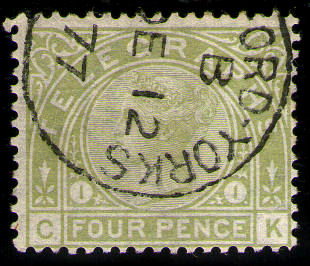 |
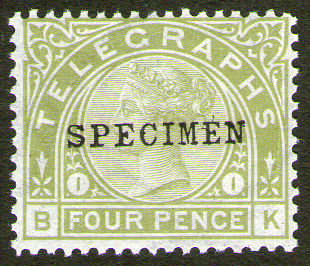 |
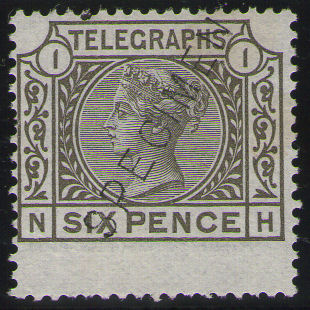 |
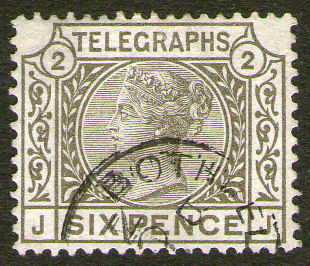 |
| 4d plate-1 | 4d plate-1, SPECIMEN Type 9 | 6d plate-1, SPECIMEN Type 11 | 6d plate-2 on Crown watermark. |
Note that the 4d is normally watermarked sideways, NOT sideways-inverted as both the SG and Stoneham catalogues say.
There are however 3 known used examples of the 4d with watermark sideways-inverted.
Hiscocks makes no mention of watermark orientation. Langmead and Huggins give it correctly.
There is an example known of the 6d plate 1 with sideways-inverted watermark.
Note that the 6d plate 2 is commoner on Crown (sideways-inverted) watermarked paper than with spray.
Stoneham erroneously give 6d plate 2 Crown watermark as sideways instead of sideways-inverted.
The One Shilling value was the basic rate for telegraphs and there were many plates used.
Plate 1 was issued 1/2/76 with sideways-spray watermark, and plates 2 to 10 were subsequently issued in green before the colour was changed to brown-orange in October 1880.
Plates 10 and 12 were issued in brown-orange on sideways-spray watermark until the watermark was changed to sideways-Crown February 1881.
Plates 11 and 12 were issued in brown-orange on sideways-Crown watermark. With plate 11, the watermark is about equally common sideways-inverted.
 |
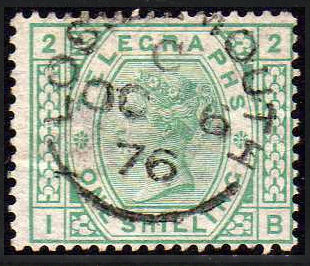 |
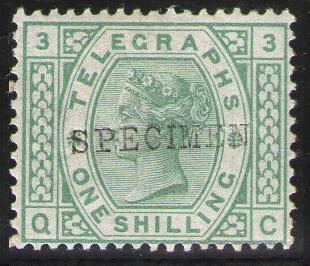 |
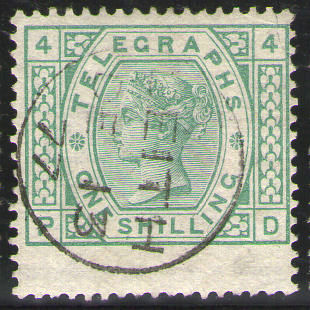 |
| 1s plate-1 | 1s plate-2 (Source: Andrew Higson) | 1s plate-3, SPECIMEN Type 9 | 1s plate-4 |
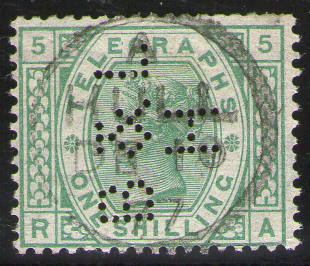 |
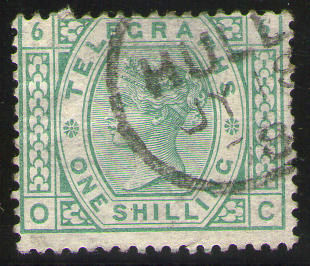 |
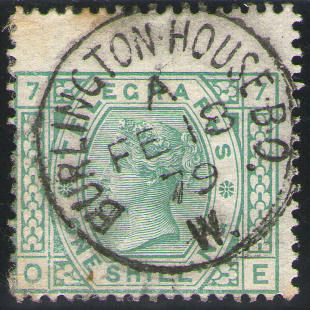 |
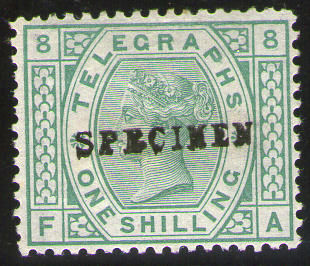 |
| 1s plate-5 (with perfin, see note below). | 1s plate-6 | 1s plate-7 | 1s plate-8, SPECIMEN Type 9 |
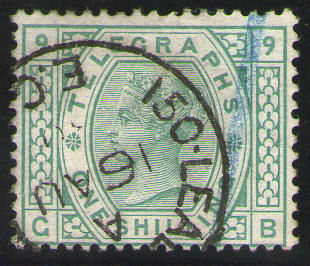 |
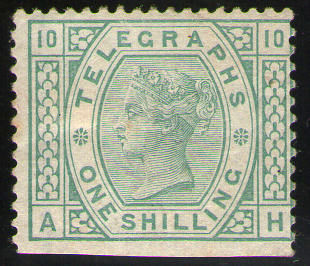 |
 |
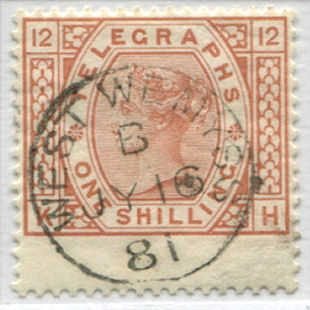 |
| 1s plate-9 with crayon mark (see note below). | 1s plate-10 green (amputated wing, (notes below) | 1s plate-10 brown, SPECIMEN Type 9 | 1s plate-12 brown (sideways-spray wmk.) |
| Courtesy of Ian Pinwill | |||
| Stanley Gibbons describe plate 11 as watermark Crown-sideways but give the same catalogue value for Crown-Sideways-inverted. -----> In my experience, Crown-Sideways-inverted appears to be the most common. |
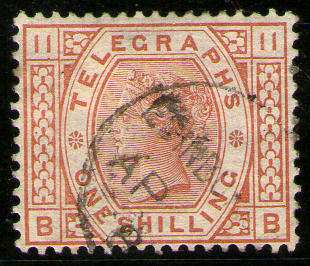 |
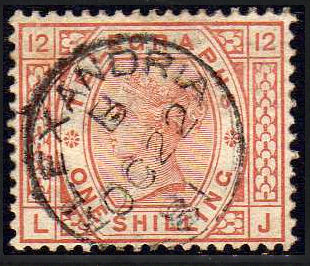 |
<----- Plate 12 Crown wmk. image source: Andrew Higson |
| 1s plate-11 (sideways-Crown wmk.) | 1s plate-12 (sideways-Crown wmk.) | ||
Note that the Stoneham catalogue gives T25 as plate 11 brown on spray watermark paper. It should be plate 10.
The shilling brown plate 11 is normally (about 80-90%) sideways-inverted as Langmead and Huggins say. SG and Stoneham say inverted.
SG prices them both the same, but Stoneham prices sideways-inverted unused slightly cheaper.
SG list plates 2, 4, 5, 6, 7 and 8 as also existing with sideways-inverted watermark, though only pricing plate 2 unused.
Stoneham lists plates 2, 4, 5 and 6 as also existing with sideways-inverted watermark, though only pricing plate 2 used and unused.
Langmead and Huggins list plates 2, 4, 5, 6 and 8 as existing with sideways-inverted watermark.
Anyone have examples ?
The Three Shilling value was issued 1st March 1877 on sideways-spray watermark (also known sideways-inverted). In August 1881, the watermark was changed to sideways-inverted-Crown
Those on Crown wmk. are scarcer than the £5.
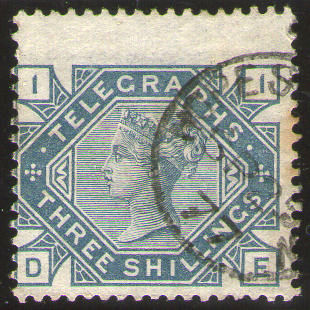
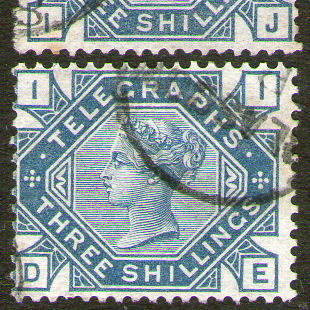
Both of these 'D E' stamps have Spray watermark, the stamp on the right has had the wing margin removed
and perforations added - fairly convincing unless you look closely and check perforations.
| These on the other hand are genuine 3s wmk. sideways-Crown, legitimately lacking the wing-margins. 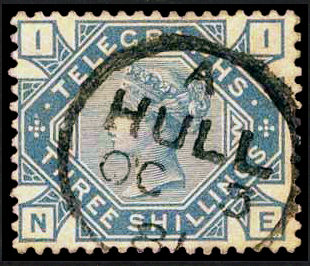
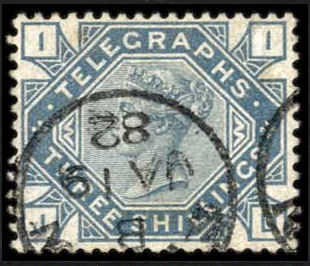 NE and JD, Note the dates. (images: courtesy of Grosvenor Auctions) |
Earliest known use, 27 August 1881 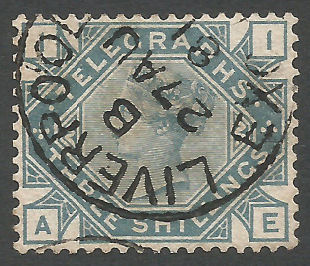 Courtesy of Chris Potts. |
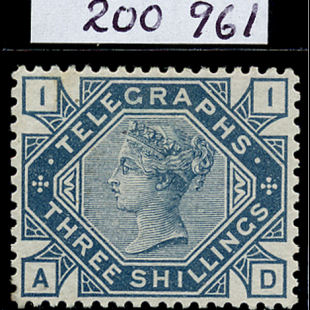 Courtesy of Mike-Holt.com |
The Five Shilling value started with Maltese Cross watermark, Perf.15 x 15½ for plates 1 (1/2/76) and 2 (1880) then switched to Perf.14 for plate 2 (1880).
Later (between 14 and 20 May 1881) Plate 3 was issued on sideways-Large-Anchor watermark, Perf.14.
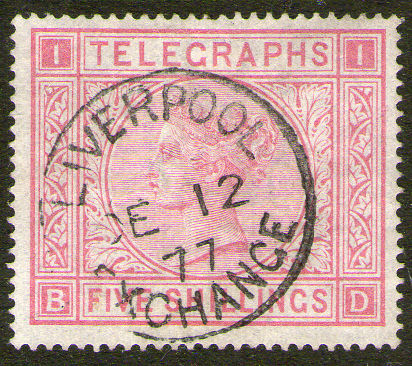 |
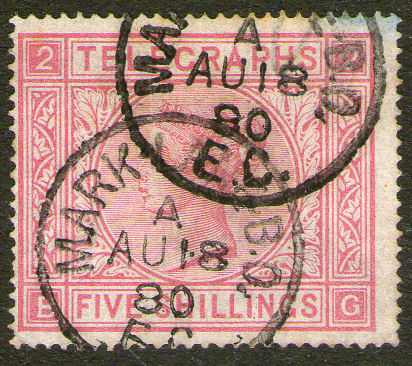 |
| 5s plate-1 | 5s plate-2 (Perf.15 x 15½) |
 |
| 5s plate-1, SPECIMENs Types 8, 9 and 10 - Courtesy of Grosvenor Auctions. |
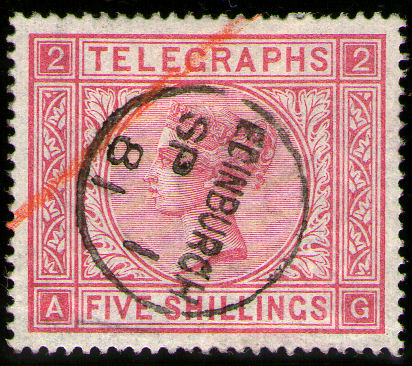 |
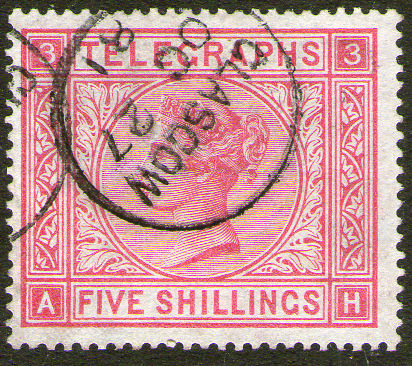 |
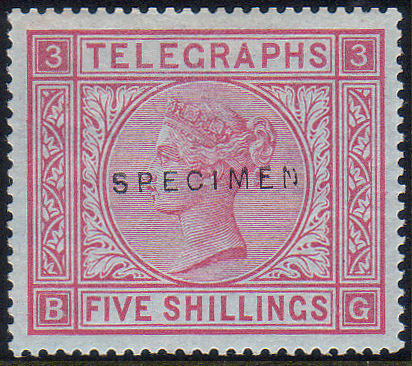 |
| 5s Plate 2 (Perf. 14) with crayon mark (see note below). | 5s plate-3 (Perf. 14), Wmk. Anchor (sideways). | 5s plate-3 Specimen type 12, courtesy of Ian Pinwill. |
The Ten Shilling value (1/3/77) was only ever Plate 1, Wmk. Maltese Cross, Perf.15 x 15½
 |
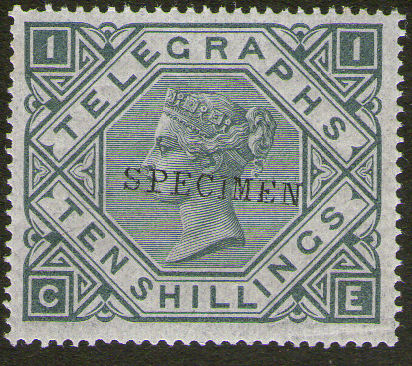 |
| 10s Plate 1 | 10s plate-1, SPECIMEN Type 9. |
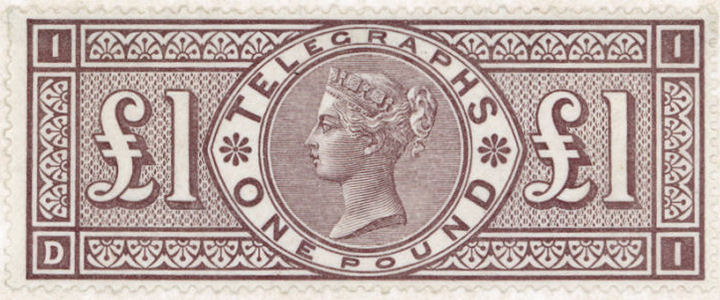 |
| The £1 value was only ever Plate 1, Perf.14, wmk. Three Shamrocks (sideways). Image courtesy of Mark Gibson. |
Post Office Telegraph £5
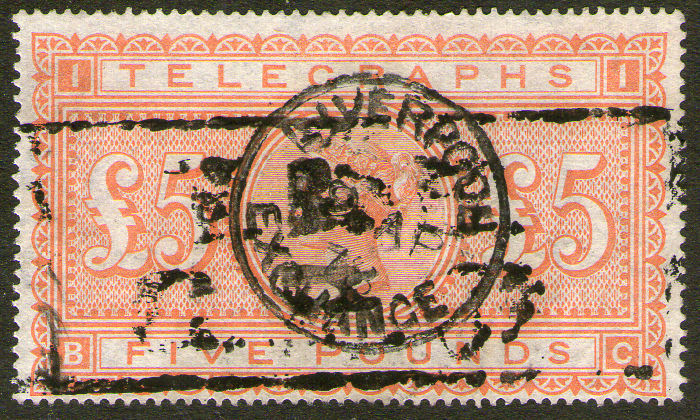 |
| The £5 value (1/3/77) was only ever Plate 1, Perf.14, Wmk. three Shamrocks (sideways-inverted) as below. |
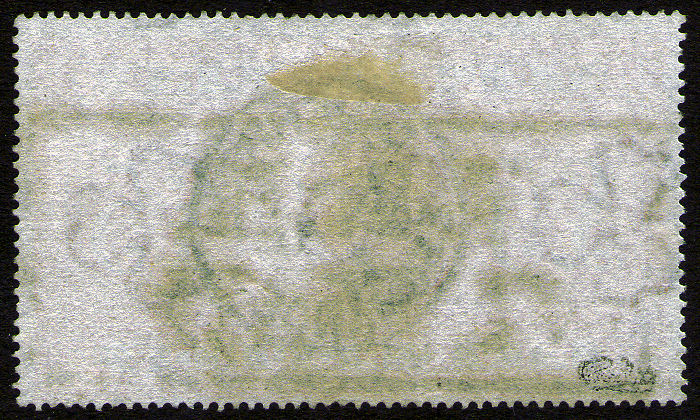 On 26/8/81 the abolition of the telegraph stamps was authorized. At the end of 1881, the £5 plate was converted for postal use in a way similar to the creation of the halfpenny.  As can be seen here the Postage and ornaments forme was not always perfectly aligned, as with the halfpenny. Even after conversion, its use did not really change, it was still used as for telegraphic accountancy purposes. See what Stanley Gibbons say about it. |
For those with a Stoneham Catalogue, T25 should be plate 10 not plate 11.
Perfins on telegraph stamps are surprisingly scarce.
 |
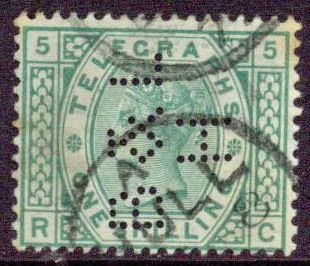 |
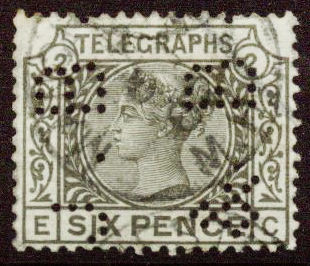 |
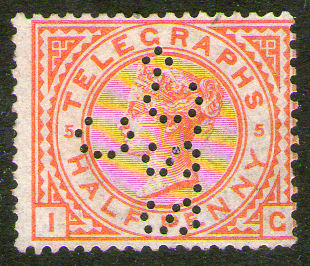 |
Here is my RA again (as shown above) together with RC and a 6d plate 2 (crown wmk.) perfined J.B & B, courtesy of Roger de Lacy-Spencer.
The halfpenny perfined C / S.S.Co. (Cunard Steamship Co., Liverpool.) is another of mine.
It has been estimated that there are less than 100 examples known. However, as interest grows, more are coming to light. My revised estimate is about 200.
The Perfin Society also have a large database.
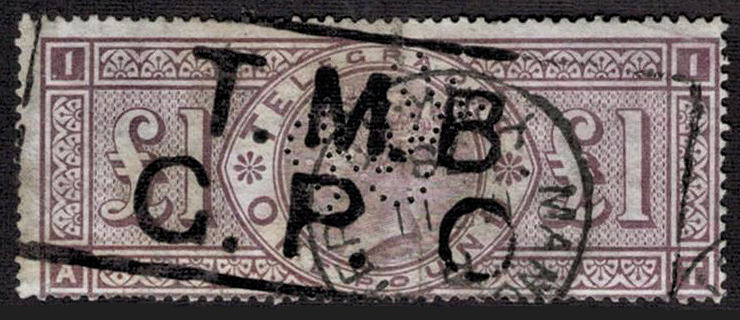 |
 |
| This is one of only 3 (currently) known examples of the Pound Telegraph stamp with a perfin. Both have this perfin, which (currently) is not known on any other Telegraph stamps. The other two are lettered BG and BR. Image courtesy of Roger de Lacy-Spencer. |
Ralli perfin of Ralli Brothers, Merchants of Peter St, Manchester. Courtesy of Jeff Turnbull, formerly Publications Officer of the The Perfin Society. |
I have now added a new page for GB Post Office Telegraph stamps with Perfins.
I would like to hear from anyone that has any more.
Railway cancels also seem scarce on Telegraph stamps.
Crayon marks are often found on Telegraphically used items (and parcel used). It is really, really not a good idea
to try and remove them, many good stamps have been ruined that way. Accept it as an important part of the stamp.
In a similar way, many wing margins (on telegraphs and postage stamps) have been cut off for either aesthetic reasons,
or simply to make them fit in a box on a printed album page ! In general it is not a good idea to do anything to a philatelic item that cannot be undone.
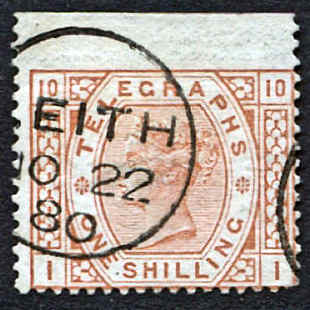
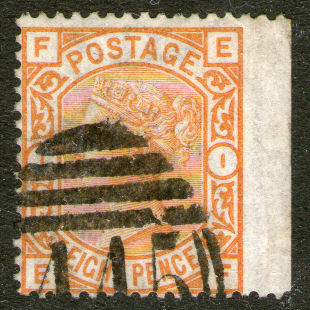
the 1s brown though is sometimes found with a guillotined wing as with the 8d postage stamp of the same period.
1s. Image courtesy of Ian Pinwill.
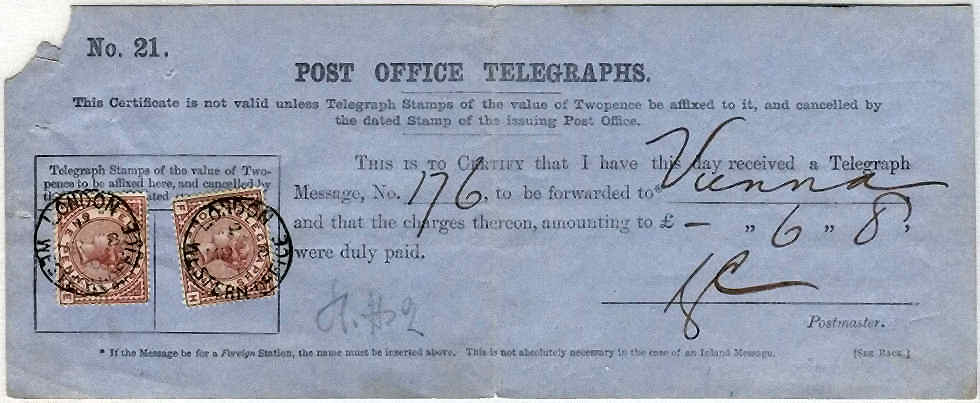
Receipts could be obtained for 2d in stamps which were attached to the receipt and cancelled. This was the only legitimate source of used telegraph stamps !
The rest, along with the forms they were on, were supposed to have been pulped. Presumably this was primarily to protect confidentiality,
but considering the ready market available for the stamps (even before the Post Office Telegraph stamps), there were many that escaped this fate.
Image courtesy of Ian Pinwill.
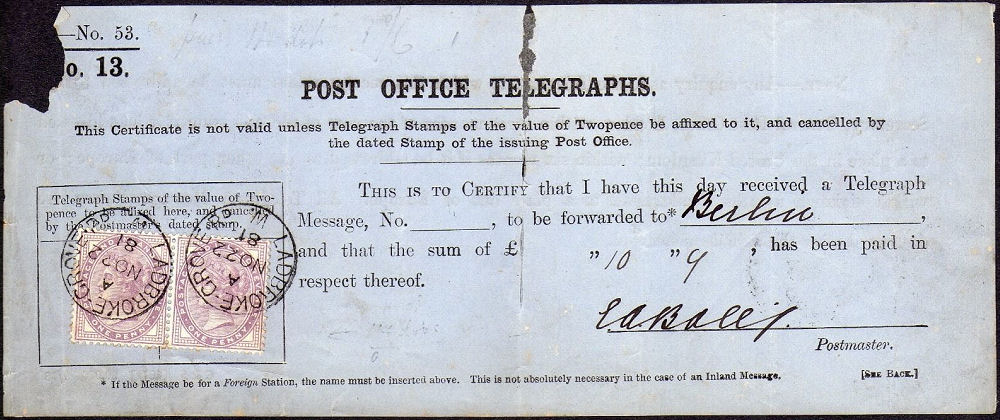
A later one dated 22/11/81 using postage & revenue stamps - courtesy of Andrew Higson.
It is unusual to find stamps still on a piece of telegraph form.
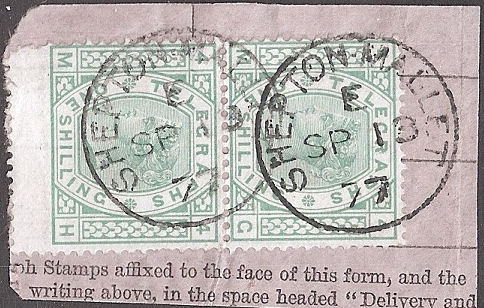
This image courtesy of Michael Goodlad who particularly collects stamps with
the check-letters MG (his initials) and would be interested in buying examples of GB Victorian stamps lettered MG if you have any.
Here is a virtually complete telegraph form (half size) of November 1881, shortly before telegraph stamps went out of use.
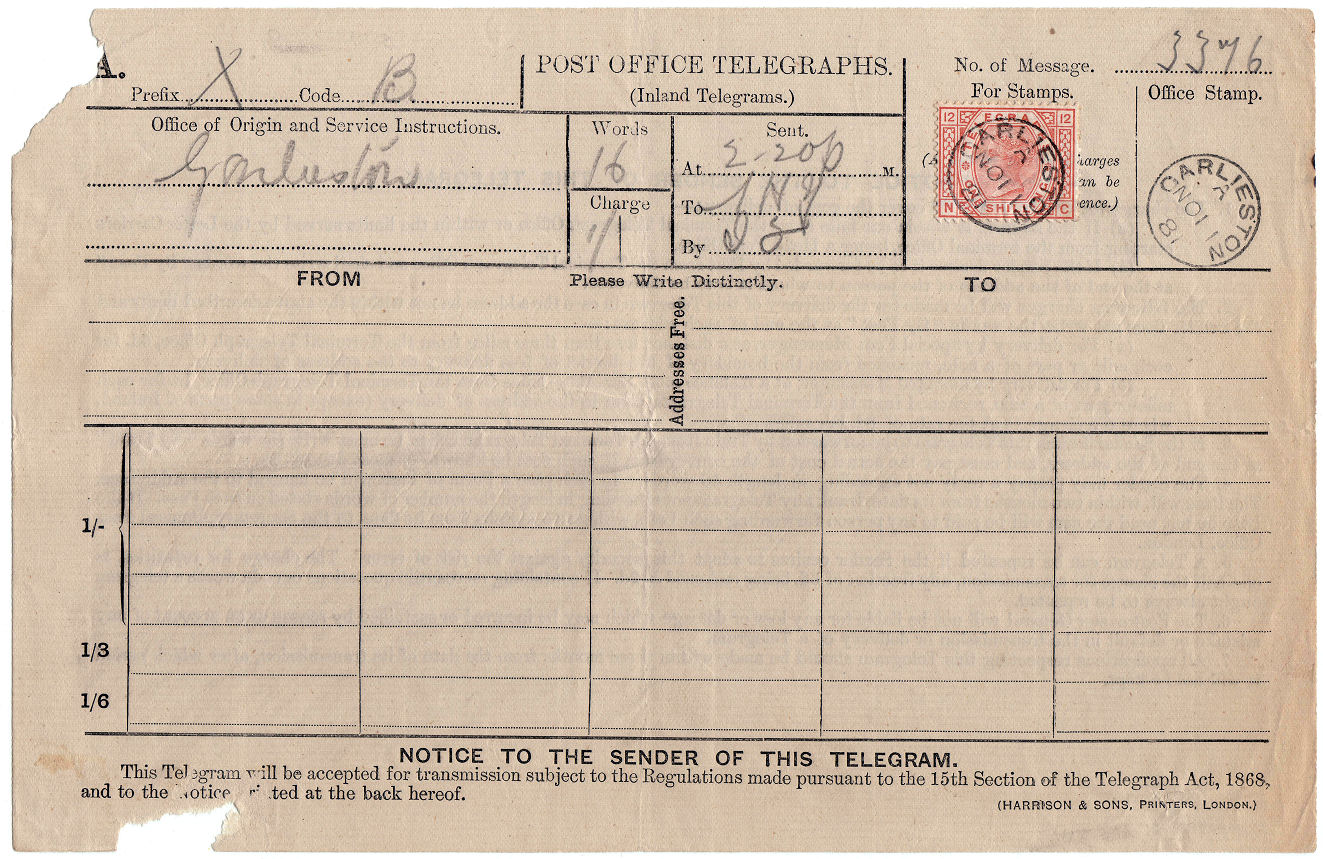
Presumably it escaped destruction because the message was on a separate sheet.
Image courtesy of Steve Lawrie.
Here is an almost complete telegraph form of April 1884.
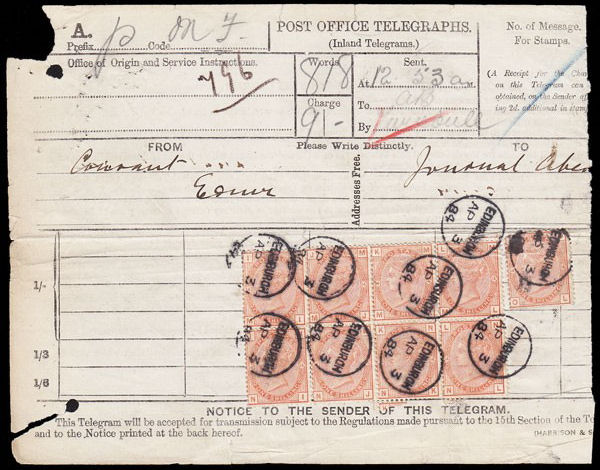
Again, presumably it is almost complete because the text to be transmitted for the journalist was on a separate sheet.
Image courtesy of Andrew G Lajer.
Peter Langmead and Alan Huggins list Post Office Telegraphs together with figures for the numbers issued.
The figures go some way to explaining the current scarcities and market values, but also highlight some anomalies
With the shilling for example, plates 4 and 5 are fairly abundant while I have yet to obtain plate 2, despite the fact that the same numbers were issued of each of them!.
Comparing the 1s plates 8 and 9 is also interesting, the figures below show that for plate 8 mint is twice as common as used, whereas for plate 9, used is nearly 3 times as common as mint.
Strangely though SG price both plates the same (Stonehams follow suit but with lower prices). Appropriate for plate 9 but ridiculous for plate 8.
It would seem that the current scarcities are an indication of times when quantities were 'rescued' from destruction.
All of my dateable plate 4 and 5 stamps (9) are dated in December 1877.
For the sixpence plate 2, the figures suggest that the Crown watermark should be half as common but the reverse seems to be the case.
Also the figures (and Stanley Gibbons) suggest that the 3d plates 4 and 5 should be much commoner than they are, commoner than the 10/- which they are not! I don't have either, but I have 5 examples of the 10/- .
Working over a period of 10 years, a database of 9874 examples of Post Office Telegraphs to date have been recorded from a multitude of sources, taking care to avoid duplication.
This constitutes 7778 used examples and 2096 mint.
The results hold surprises even for a cynic like me, and I am sure many will find them hard to believe.
This first graph gives the percentages of the 7778 stamps for each type of USED Telegraph Stamp, from the commonest down to the rarest.
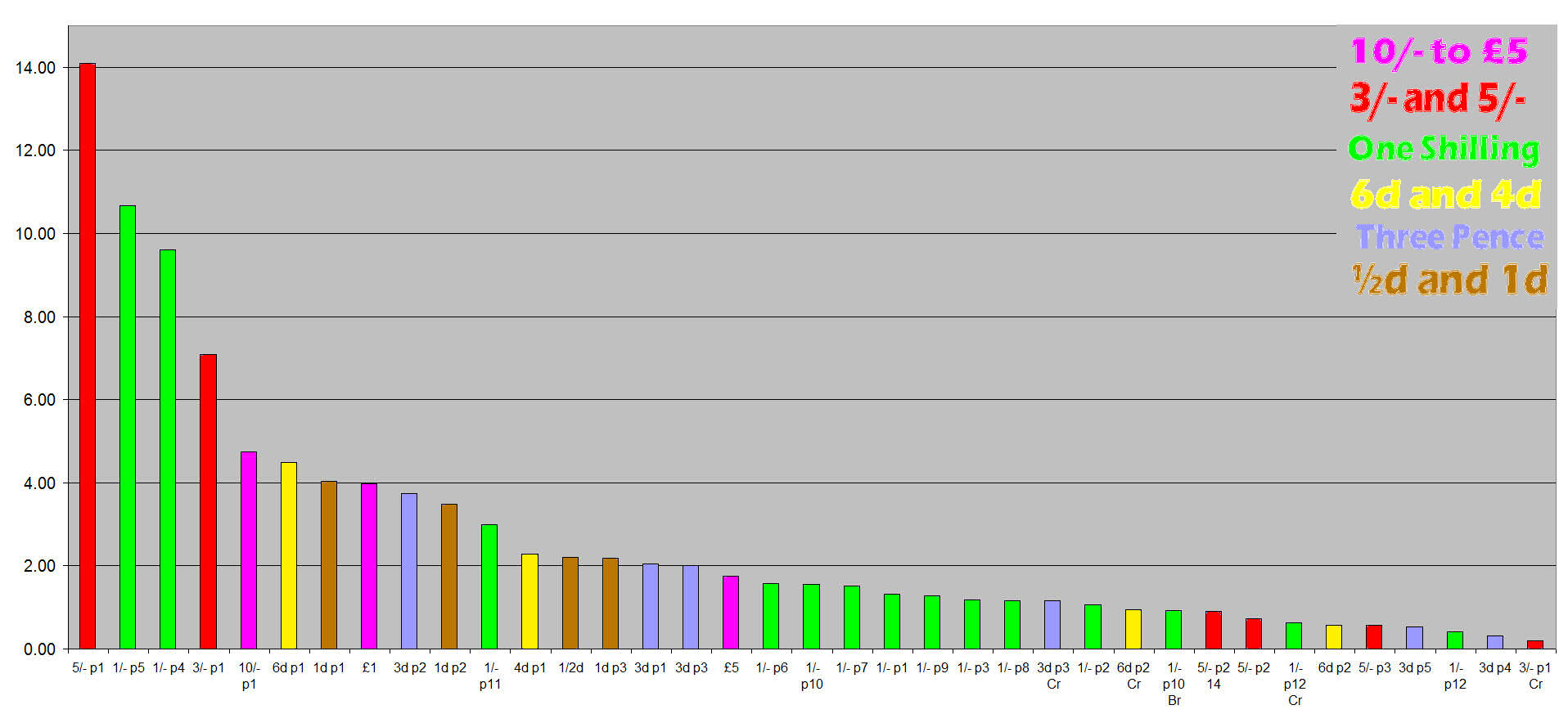
I now see why I don't have any 3d plates 4 or 5.
Why are the 5/- Plate 1 stamps so common? Because they were preferentially 'rescued', demand was higher for the high values
For similar reasons the £5 orange is now commoner than the 1s plate 6 in used condition, though not unused (see below) as the same rescuing process could not be done.
Condition is another matter. The larger a stamp is, the more likely that some part will be damaged.
The 'rescues' were also sporadic. Many of the telegraph stamps are dated in December 1877 for example.
Scarcity is therefore dictated by what was common at the time of 'mass escapes' rather than total numbers printed.
This graph gives the percentages of the total for each type of MINT/UNUSED Telegraph Stamp, from the commonest down to the rarest.
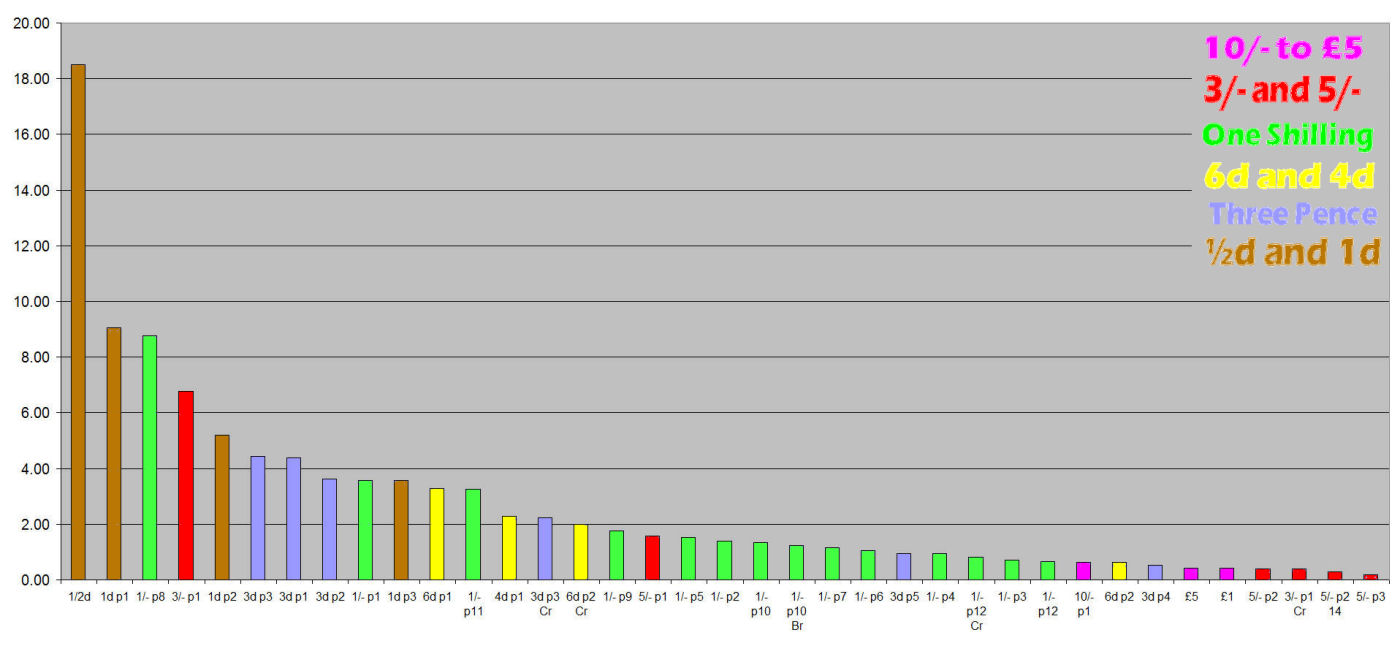
Why does the graph look so different for Mint? For one thing, they could be bought over the counter, though probably only large companies bought them in any quantity.
The relatively high price though for some items seems unjustified. The £5 is no scarcer than the £1 but about 3 times the catalogue value !
In part this may be preferential buying by collectors, but I understand that the perforating of imprimaturs may have something to do with it.
This graph shows the percentage of used example as a function of the month of the cancel.
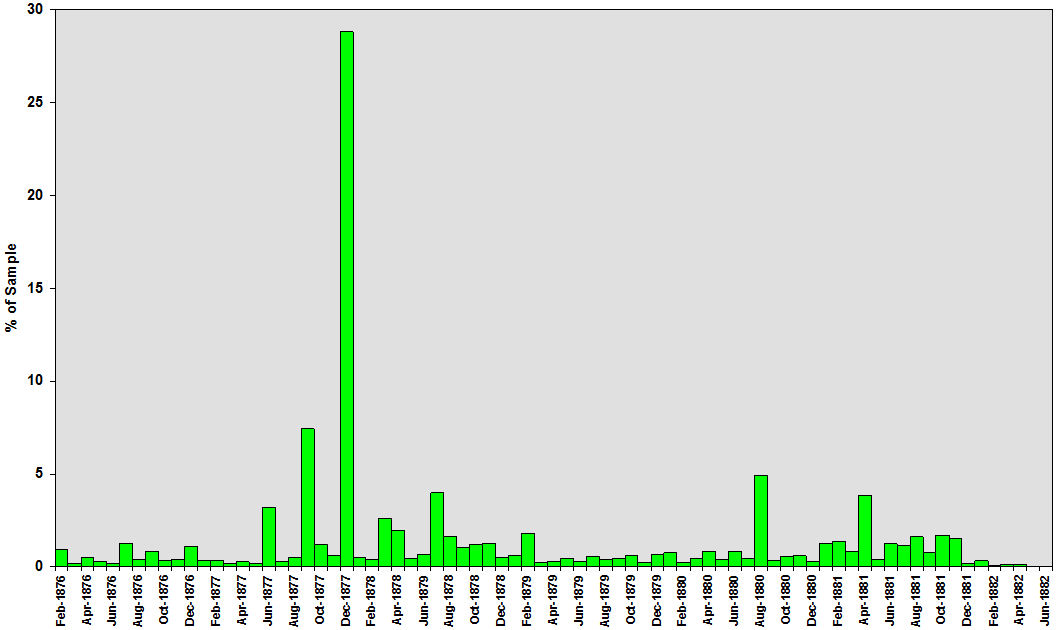
So it isn't just me that has a lot used in December 1877.
Notice though the steady continuous leakage. This is individuals across the country taking predominantly high values.
The peaks represent low as well as high values of whatever plates were in use at the time. The December 1877 peak accounts for the availability of the 1/- plate 4 and 5 today.
As well as many of the other anomalies mentioned.
|
The graphs above and below use this colour key. |
Remember that the Spray Watermarked stamps should have wing margins if they are in columns (rows) D, E, H or I. So if the bottom-right letter is D, E, H or I then
you should have a wing margin, unless it is really Crown watermarked or the wing is chopped off and possibly fake perforations added.
For the fourpenny with Garter Watermark, wing margins should occur at columns (rows) F and G.

3d Plate 3 watermark 'Spray', the middle third of a sheet showing the E and H Wing margins, (SPECIMEN Type 9) - courtesy of Grosvenor Auctions.
There are no wing margins with the Shamrock, Crown, Maltese Cross or Anchor watermarked paper.
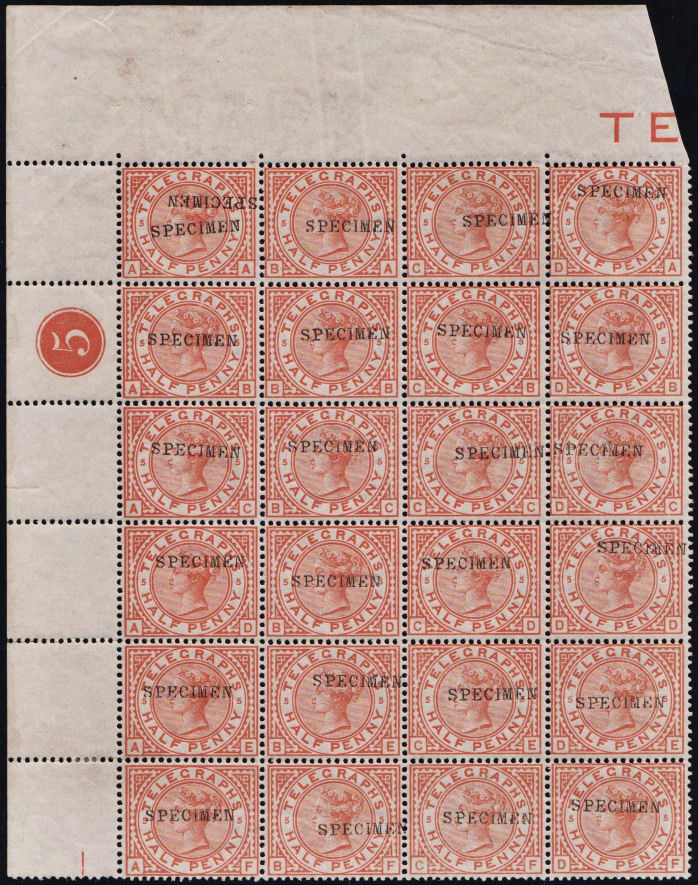 |
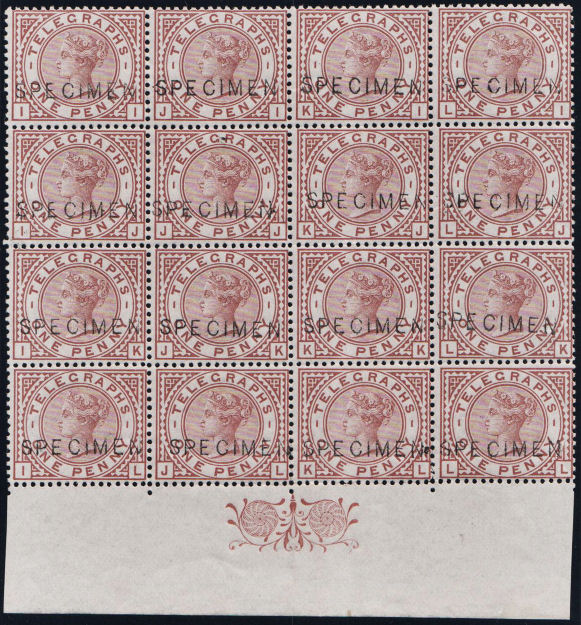 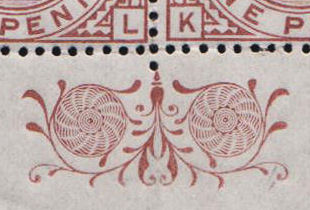 |
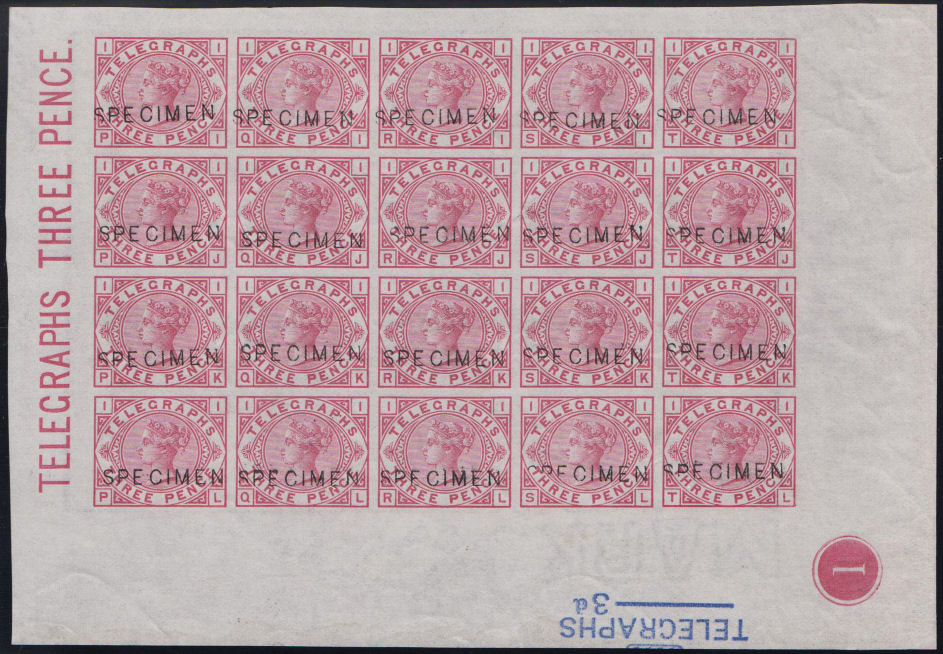 |
|
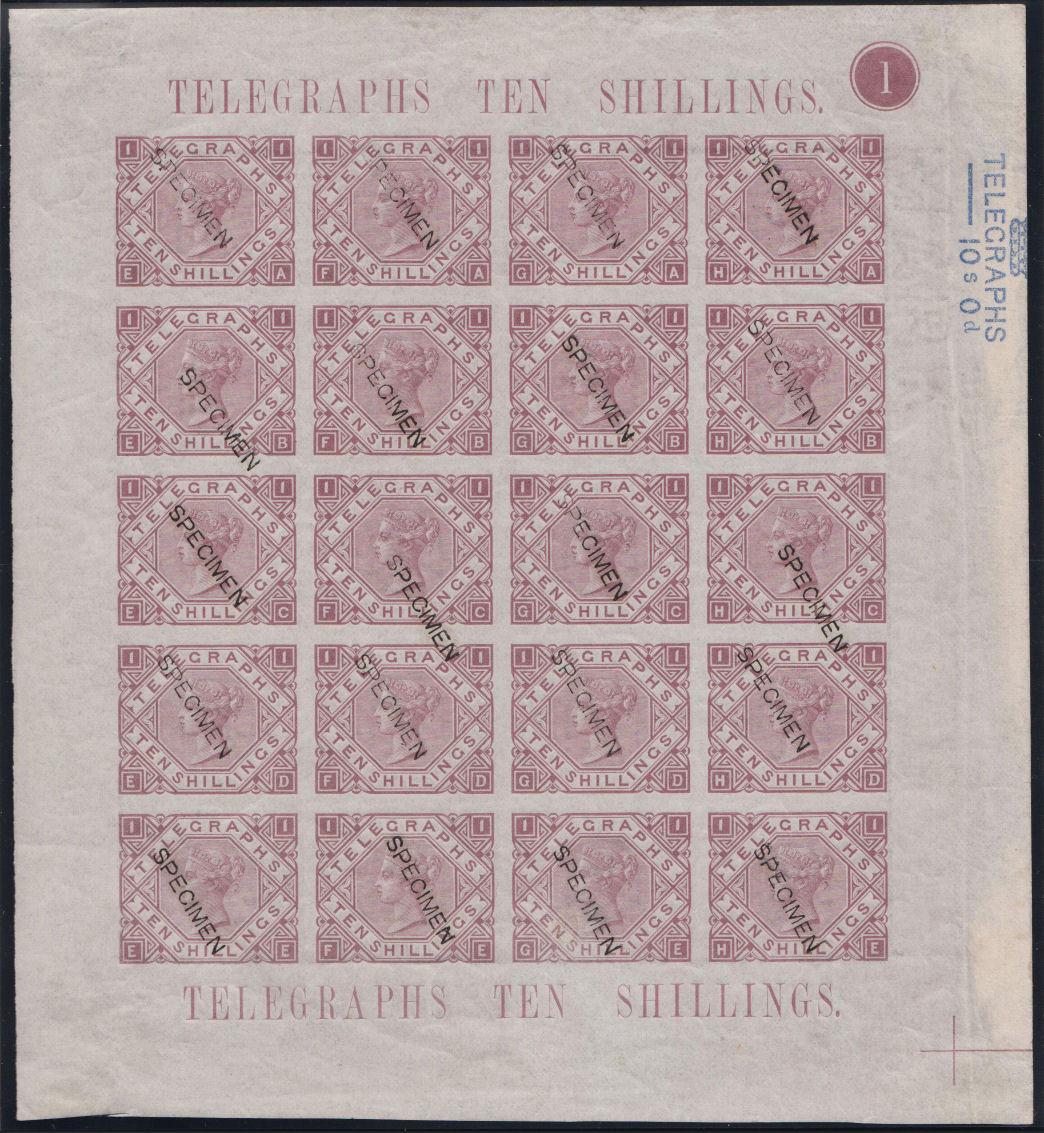 |
|
|
Some panes (illustrated at half-size) courtesy of Paul Ramsay. The halfpenny has the (first ?) 'SPECIMEN' strike inverted, then corrected. The penny shows the ornate division marker. The 10/- colour trial is a quarter of the full sheet from top-right. On three of these, "MARK" can be seen in the watermark in the corners. | |
In 1875 (20th February), T.Boucher suggested a modification to the existing halfpenny stamp for telegraphic use.
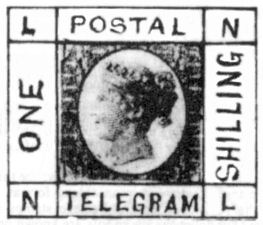
This essay was not adopted but may have influenced subsequent designs.
Illustration from Langmead & Huggins' book (Fig.76), courtesy of the
Great Britain Philatelic Society.



Unique Hand Painted Essays from the De La Rue Archives. These are in black and Chinese white on thick card,
Ex. A. J. Lowe — Images courtesy of Andrew G. Lajer.
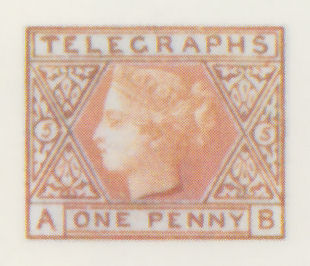

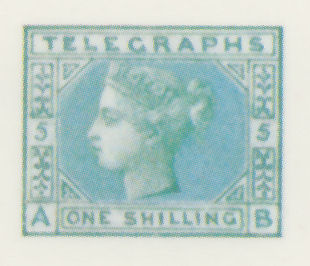
Series A, horizontal format essays of the 1d, 3d and 1/-,
from the A. J. Lowe collection sold by Phillips on 2 November 1990.
Images courtesy of Phillips, Son & Neale.
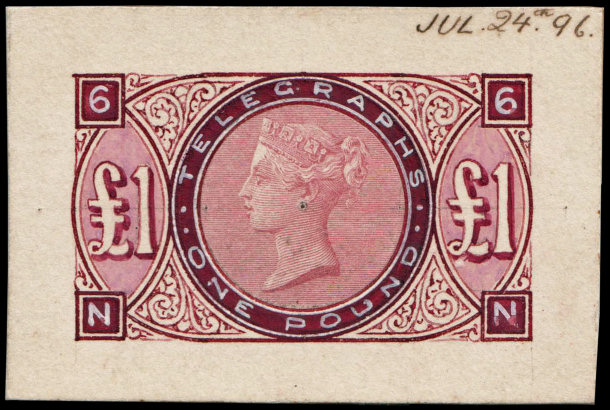
A hand-painted essay for the £1 (dated '96 in error for '76) from the
A. J. Lowe collection sold by Phillips on 2 November 1990.
Image courtesy of Paul Ramsay.
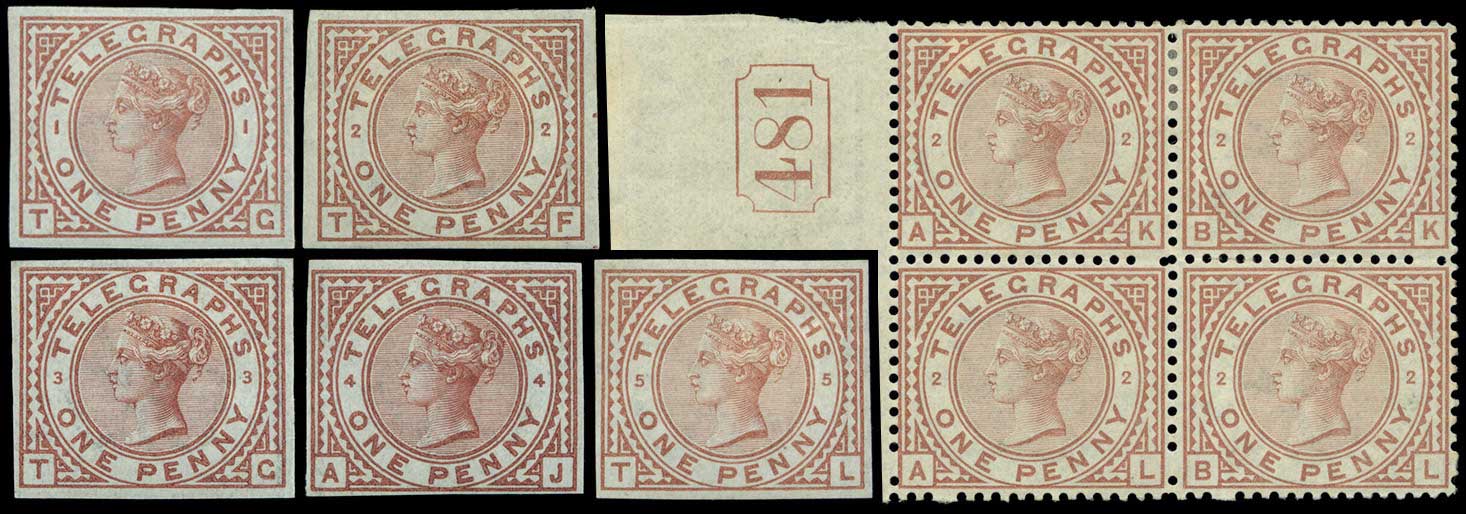

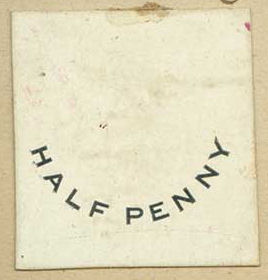
Note the different shade of 'HALFPENNY'. The weirdly perforated block was in the same auction lot.
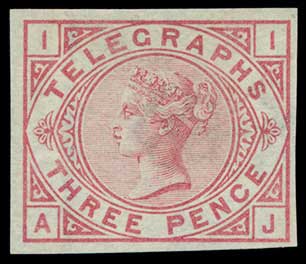

The Auction description (Sale 62, Lot 1134) for plate 1 says "Langmead records only six known letterings, of which four are in institutional collections."
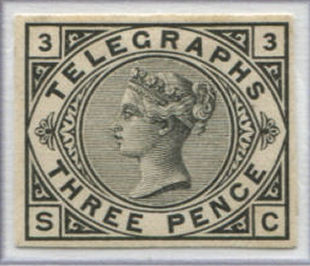
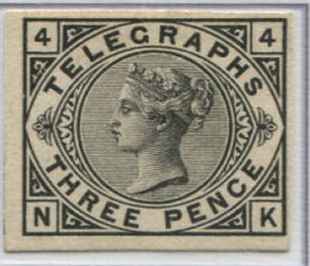
Plate Proofs of the 3d are known from plates 2, 3 and 4. Anyone have an example of Plate 2 ?
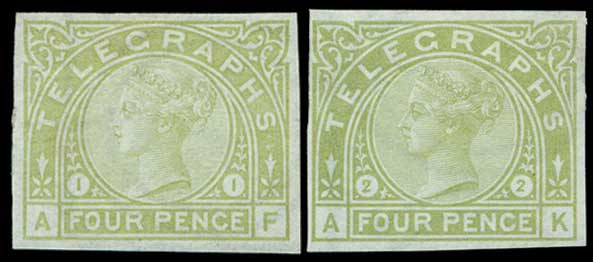
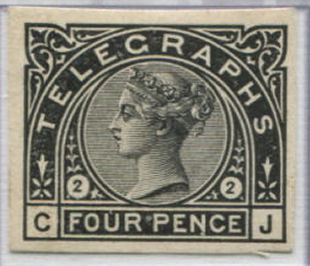
Plate Proofs of the 4d are known from plate 2 only.
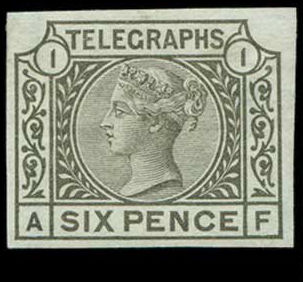
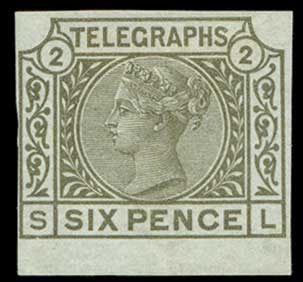
Plate Proofs of the 6d are known from plates 1 and 2.
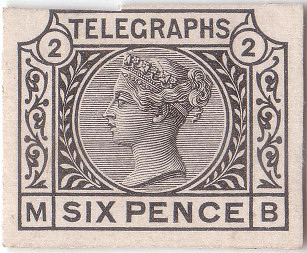
Plate 2 - courtesy of Steve Lawrie.
Anyone have an example of plate 1 ?

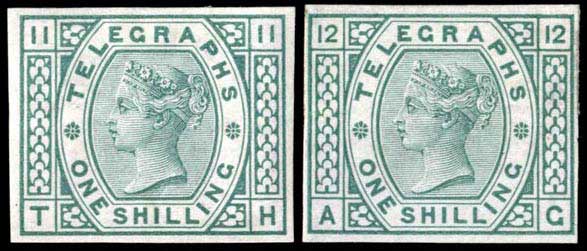
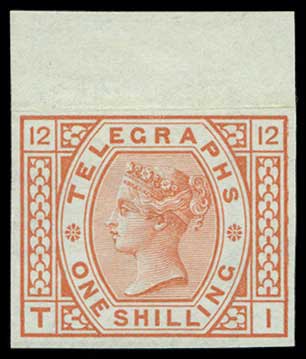
Plate Proofs of the 1/- are known from plates 2, 3, 4, 8 and 9.
 |
 |
| Plate 8 - courtesy of Steve Lawrie. | Plate 9 - courtesy of Ian Pinwill. |
Anyone have any examples of the others ?
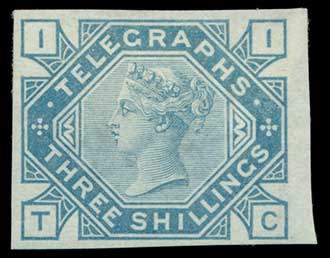 |
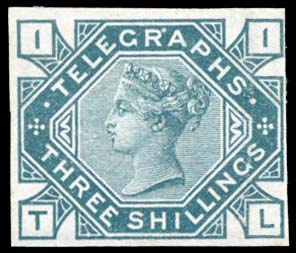 |
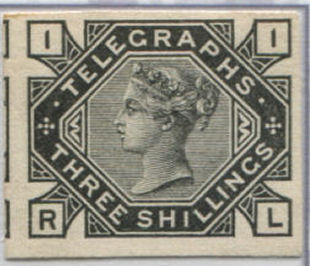
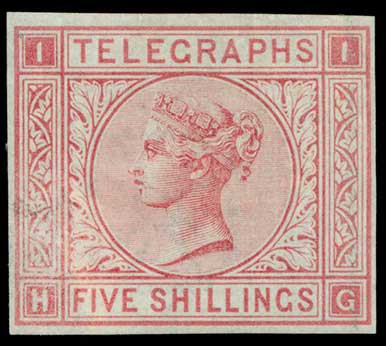 |
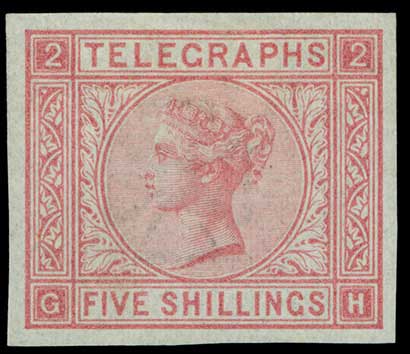 |
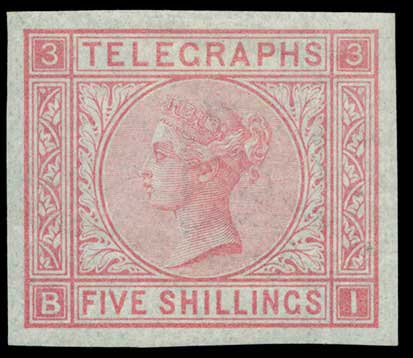 |
| These all have Maltese Cross watermarks. | ||


Plate Proofs of the 5/- are known from plates 1, 2 and 3.
Anyone have an example of plate 1 ?
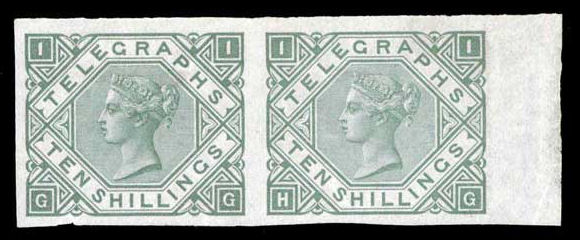

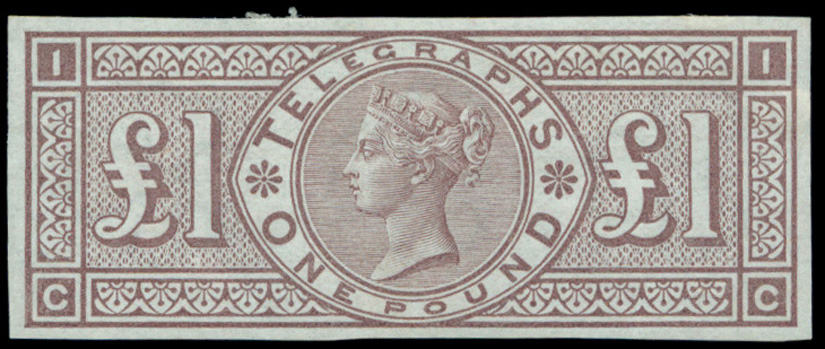
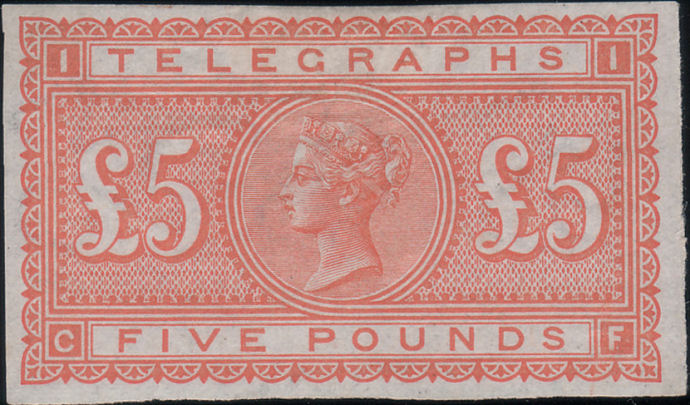
Here is a die proof with pencil marks indicating areas of improvement
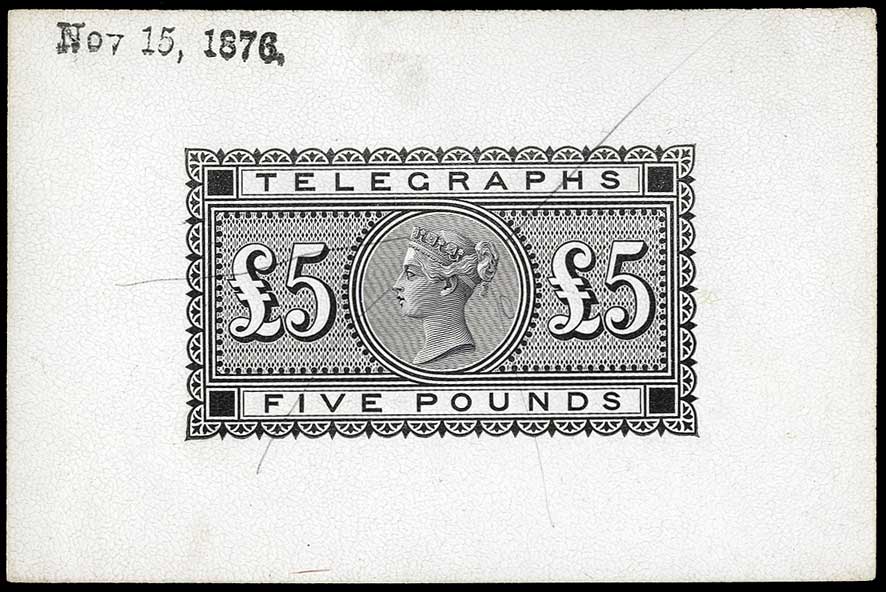
Image courtesy of Grosvenor Auctions.

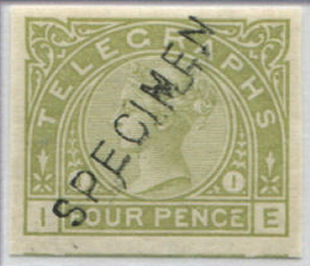
These were in a slightly deeper colour than the issued stamp (see the Type 9 specimen above).
This is Type 11 overprint. They also exist with Type 8 overprint. Anyone have an example ?

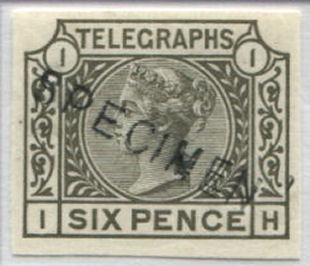
These were in a slightly deeper colour than the issued stamp (see the Type 9 specimen above).
Type 8 on the left and Type 11 on the right.
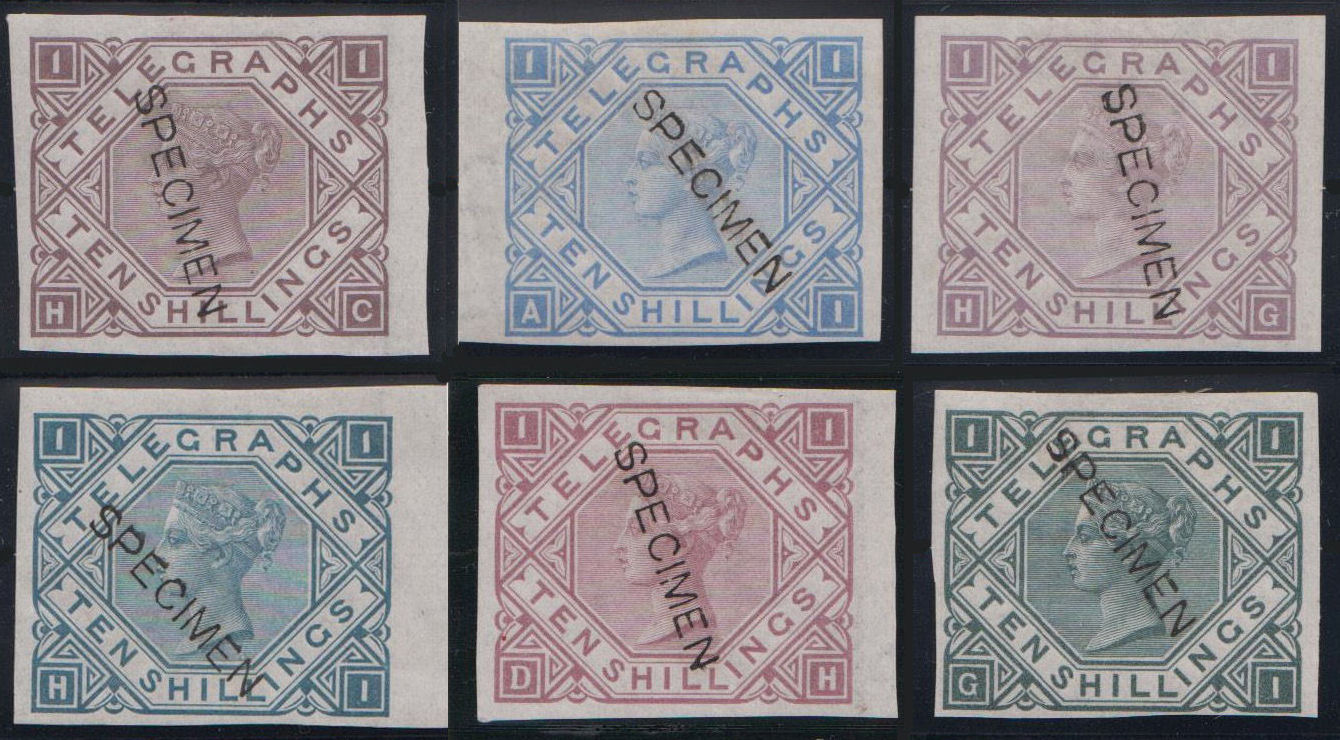
The top row, brown-lilac, pale ultramarine, dull mauve followed by
slate-blue, dull claret and grey-green all have Type 8 overprint.
The issued colour (grey-green) is also known with Type 11 overprint shown below courtesy of Ian Pinwill.
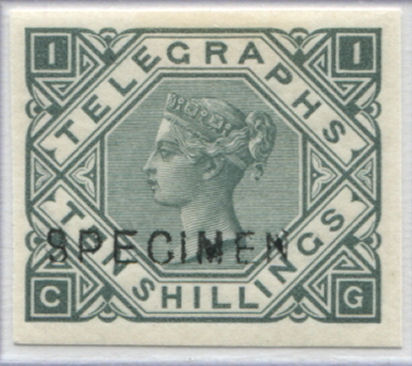
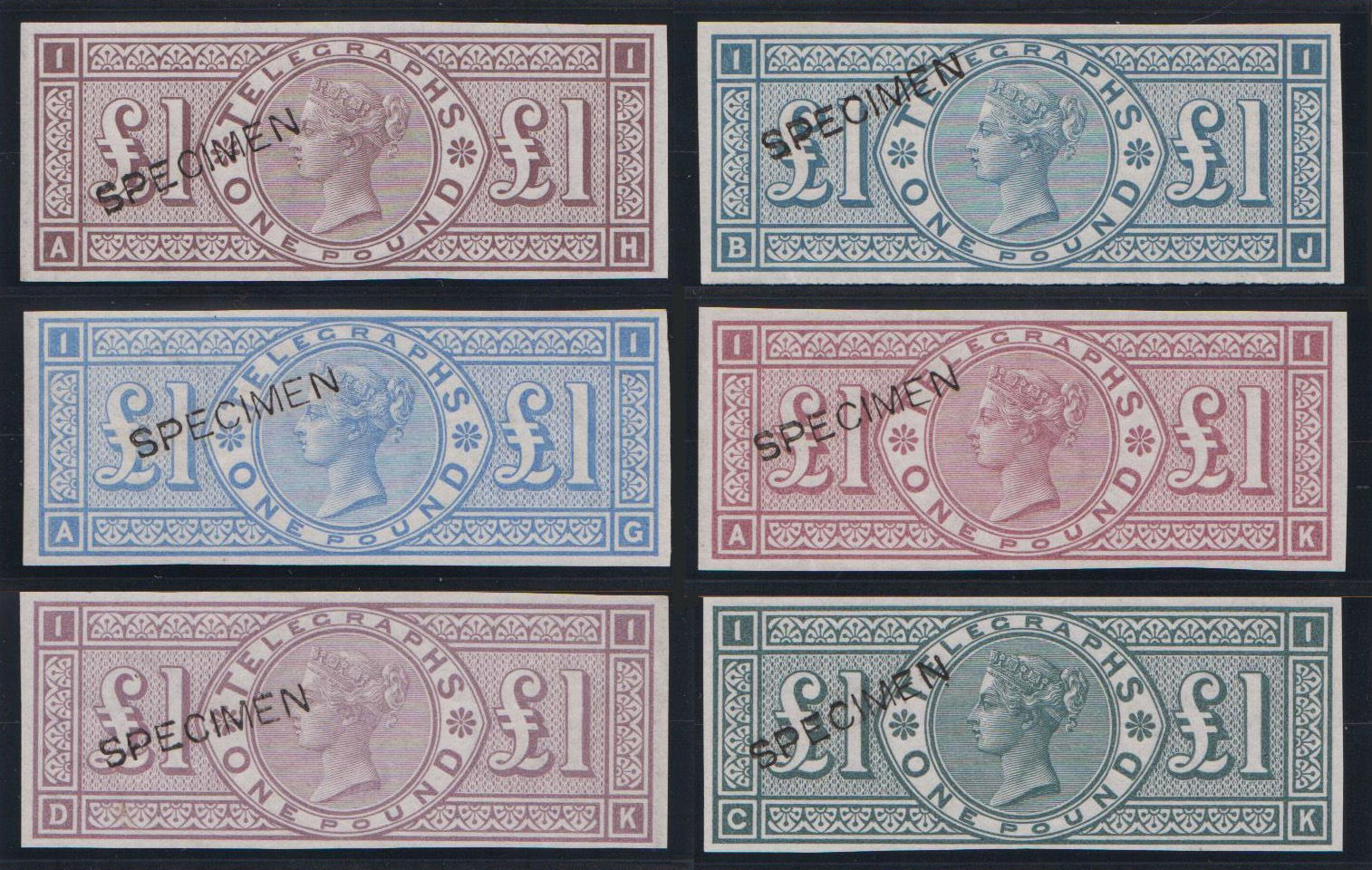
On the left, brown-lilac, pale ultramarine and dull mauve on the right
slate-blue, dull claret and grey-green all have Type 8 overprint.
The issued colour (brown-lilac) is also known with Type 11 overprint shown below courtesy of Ian Pinwill.
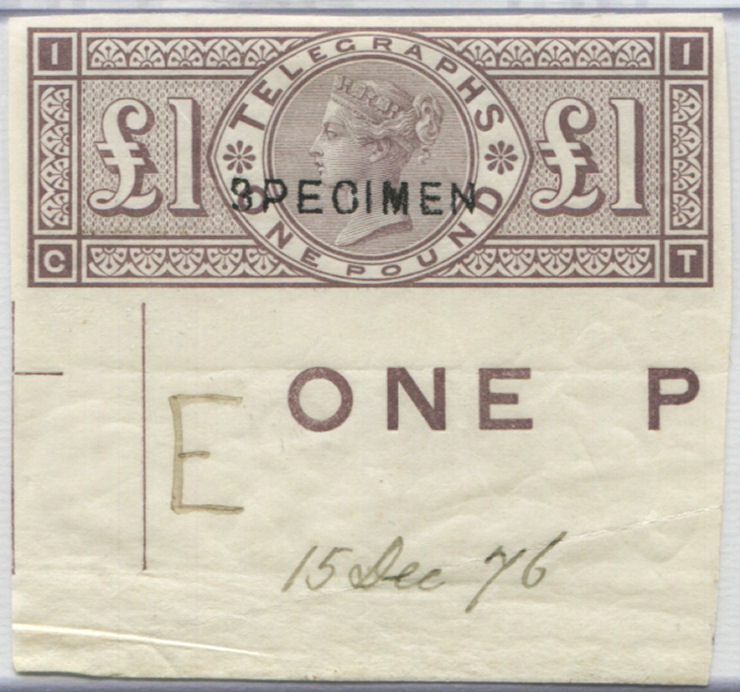
The manuscript 'E' indicates the fifth colour out of six.

On the left, brown-lilac, pale ultramarine and dull mauve on the right
slate-blue, dull claret and grey-green all have Type 8 overprint.
Pale ultramarine and printings in gold are also known with Type 11 overprint.
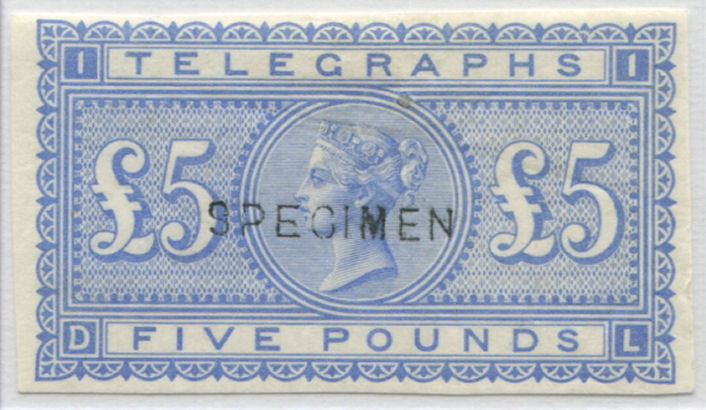 |
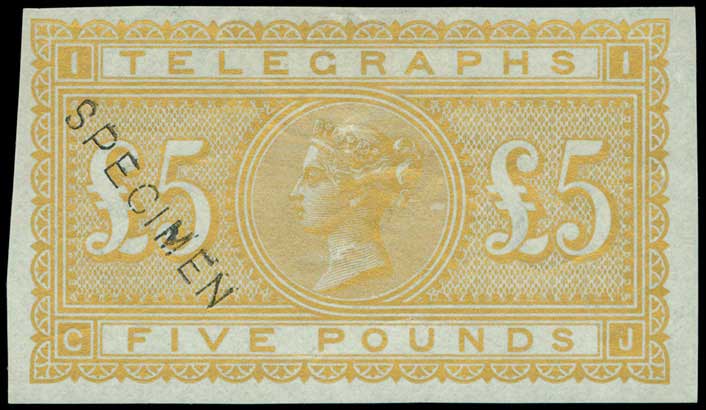 |
| Type 11 overprint on pale ultramarine courtesy of Ian Pinwill. | Type 11 overprint on gold courtesy of Grosvenor Auctions. |
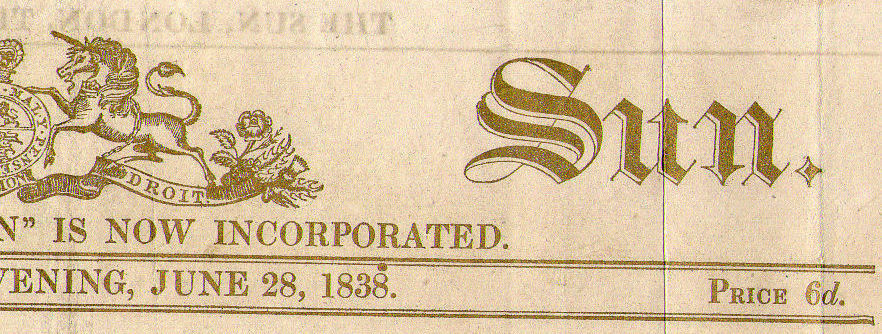 For the sake of interest, This is part of the front page of 'The Sun' of June 28, 1838 commemorating the Coronation of Victoria. It is printed in gold ink and a notice on the back says it is done at 'immense expense' but is still the usual price for subscribers, though has to be more for Non-subscribers. They give praises to 'the great ingenuity of the firm of De La Rue and Co., to the perseverance and exertions of Messrs. Clowes and Son, to the great skill of Mr. Edward Wyon the modeller, and to the talents of one of the first engravers of the age.' As I understand it the ink contains actual gold, presumably mixed with yellow ink. The difference in colour between the example above and the one to the left, is presumably down to how well the scanner handles this combination. They are both from the same column (C) of the same sheet, only the bottom half, AH-DN having the 'SPECIMEN' overprint, AA-DG without. |
1881 Colour trials with the 3d. These were in orange, blue and green on plate 3, perf. 14. Crown Wmk.
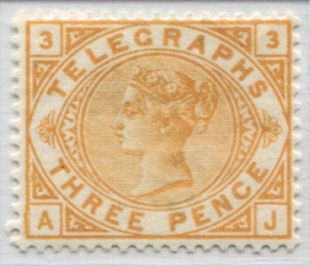

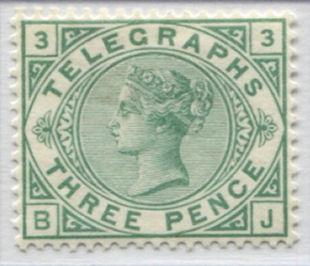
Since the Post Office had abandoned the use of Telegraph stamps when these were made, it is thought that
they were used as samples in tendering for business as was done with the 3d United Kingdom Electric Telegraph Company stamps.
Images courtesy of Ian Pinwill.
For the record, Paul Ramsay who supplied many of the images above and co-authored the GB Post Office Telegraphs book,
has three other sites :
www.gbpostagedues.com
www.gbstampbooklets.com
www.gbstamprolls.com
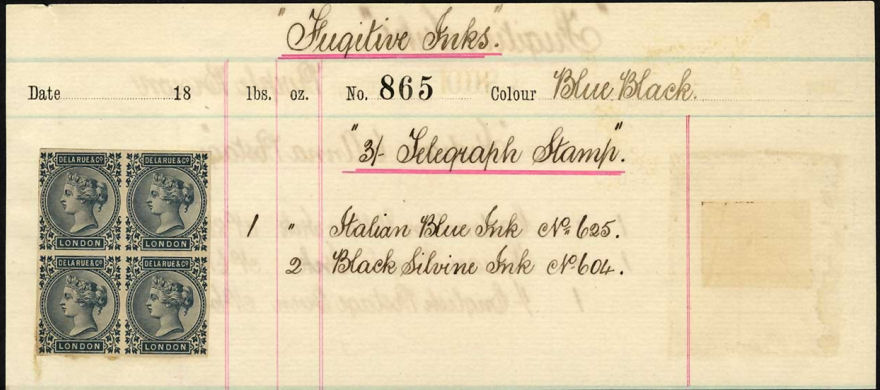
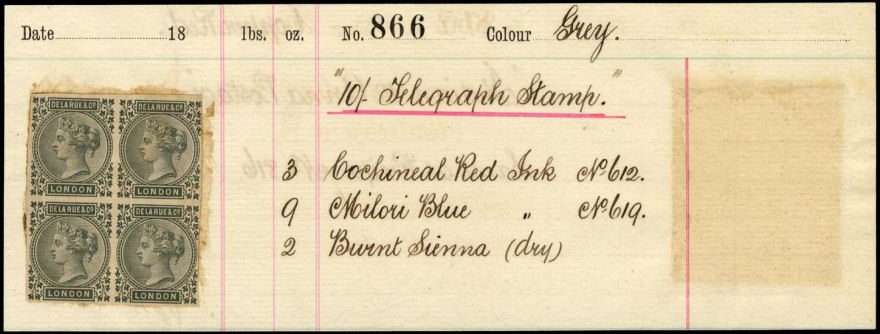
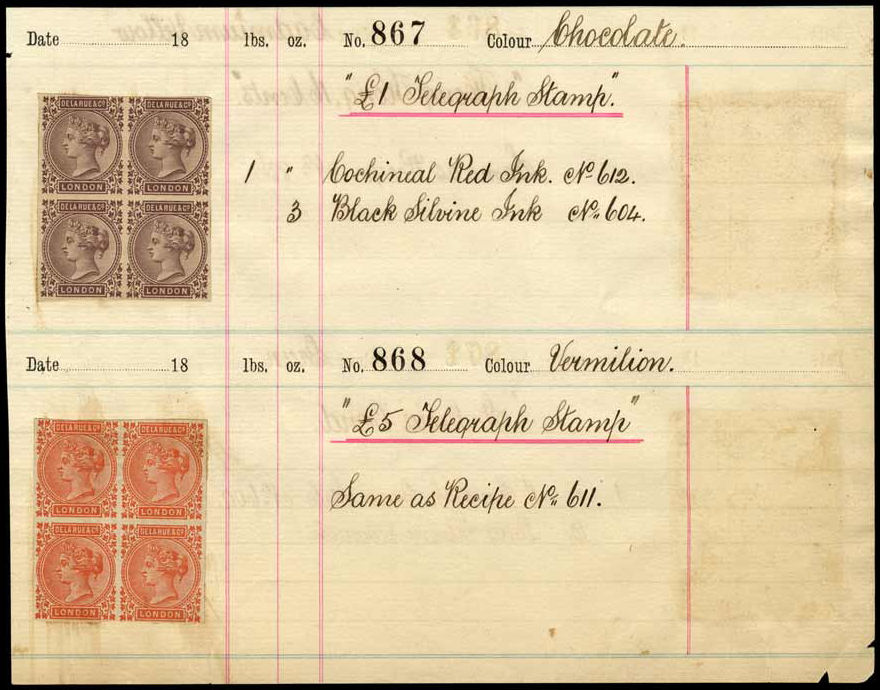
Telegraph stamps were sometimes used postally, though never officially authorized. Here are some examples courtesy of Grosvenor Auctions.
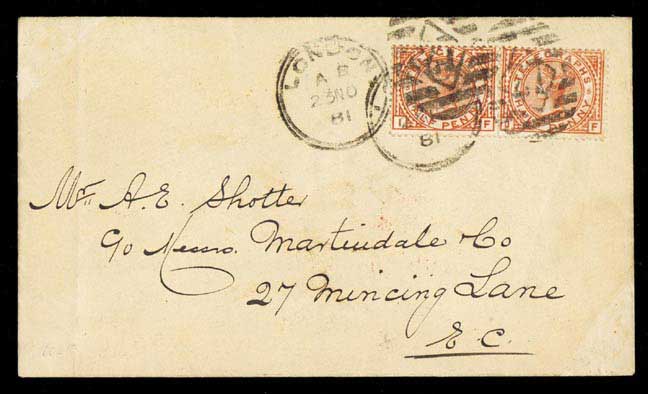
23 Nov. 1881
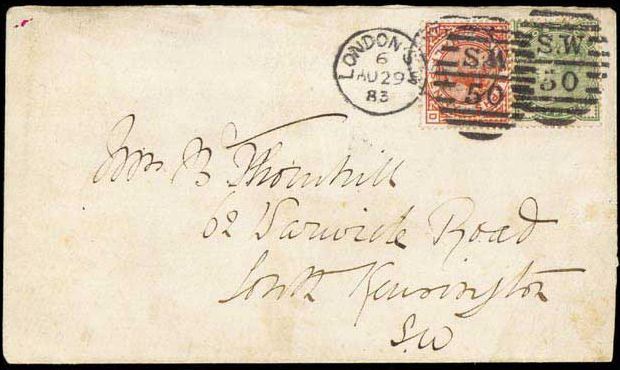
29 Aug. 1883
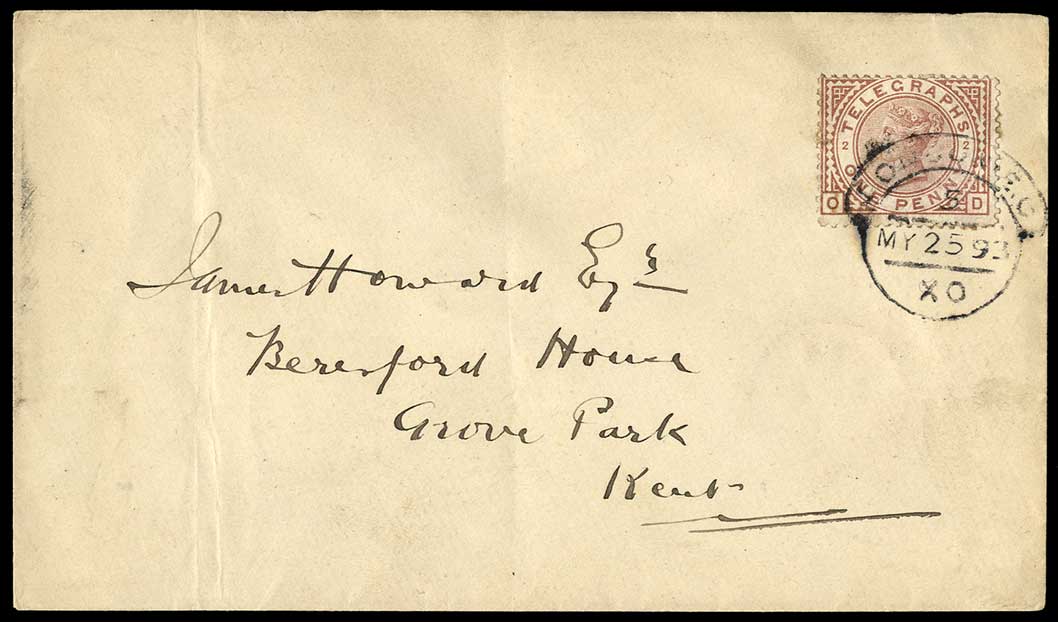
25 May 1893
The above stamps were all used in London after it had been agreed to abolish the Telegraph stamps.
The one below was sent from Lurgan in Ireland while the 6d plate 1 was still being used for telegraphs.

This was sent from Lurgan in Ireland on 16/1/1878, arriving in Cape Colony on 8/2/8[sic]
It has manuscript "Charged in error", so presumably the stamp was initially not deemed acceptable.
I was puzzled by the manuscript '3' in blue, but I am told it is the cost of the inland transport.
Image courtesy of Martien Blank.
Here is an even earlier one, sent from Hastings on 29/3/77 to Japan.
This one is much later.
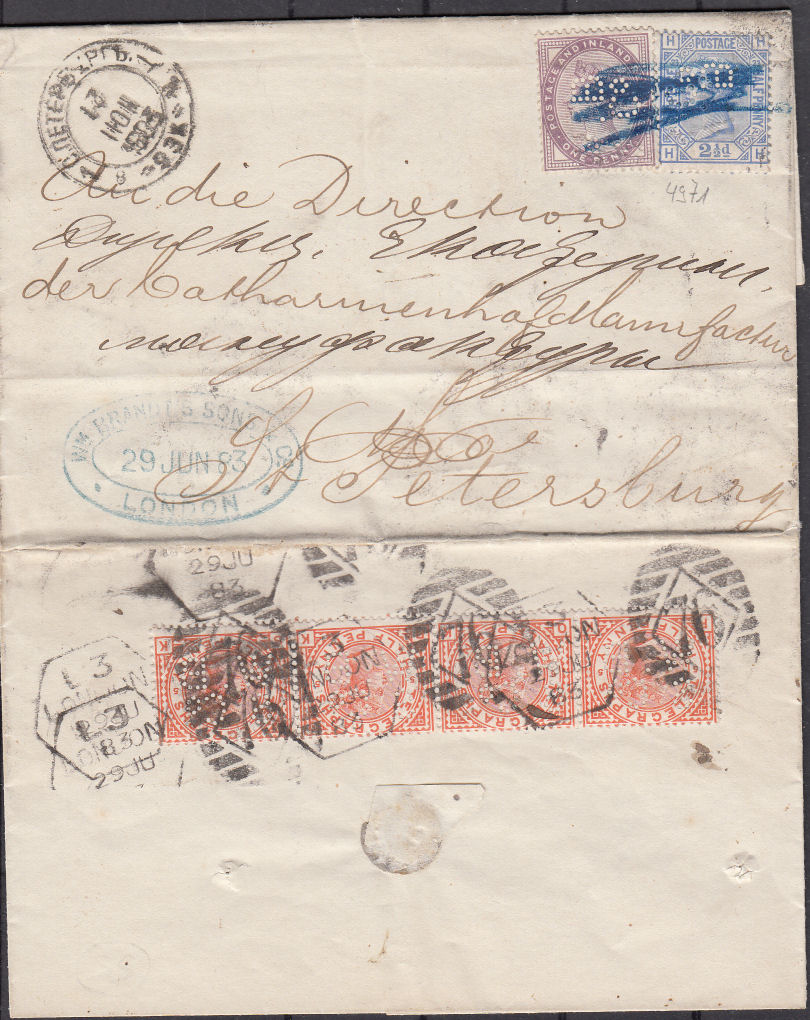
This was used to pay a late fee on 29 June 1883 at New Cross, London on a cover to St. Petersburg, arriving in July (it looks like an inverted 21 for the day).
All the stamps are perfinned W.B / S Co (Perfin Society reference W 0790.02) for Wm. Brandt's Sons & Co. (4 Fenchurch St, London).
Only two other examples are known of this perfin on telegraph stamps and they are also halfpennies used postally on the same day.
Image courtesy of Martien Blank.
This Registered Letter was sent from Wigan on 22/9/90 to Wellington, New Zealand.

It has a 6d plate 2 crown watermark (no wing) and another shillings worth of 'Jubilee Stamps'.
Image courtesy of Martien Blank.
This was sent from Bethnal Green on 26/12/90 to Halifax, Canada.
Postal use of PO Telegraph stamps then is known at least from 29/3/77 to 26/12/90
I guess as long as everyone got paid, the fact that these stamps were not authorized for postal use didn't bother too many people!
This is an unusual one: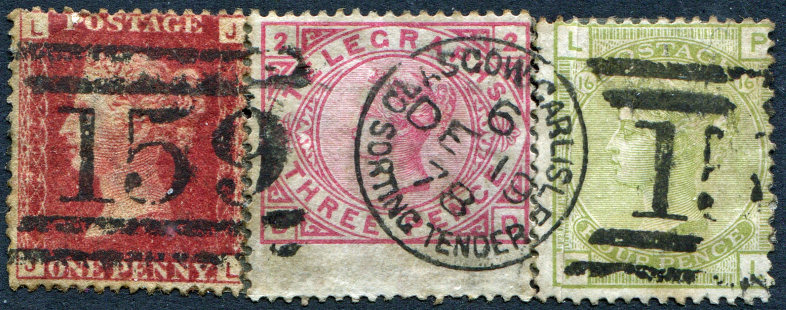
Cancelled on the Glasgow to Carlisle Sorting Tender, 19 December 1878, courtesy of Ian Pinwill.
I needed to create a page for the Telephone Stationery and decided to put the telephone stamps there also.
If anyone would still like to see it here, please let me know.
They are now on the PO Telephone Service Page.
Last updated 22nd. August 2023
©Copyright Steve Panting 2012/13/14/15/16/17/18/19/20/21/22/23 except where stated.
Permission is hereby granted to copy material for which the copyright is owned by myself, on condition that any data is not altered and this website is given credit.